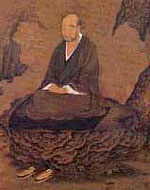Koso Wasan 39
Through the benefit of the unhindered light,
We realise shinjin of vast, majestic virtues,
And the ice of our blind passions necessarily melts,
Immediately becoming water of enlightenment.
Ice and Water

When he says, 'our blind passions ... becoming water of enlightenment,' Shinran Shonin is asserting a common theme of the Mahayana. There are two closely related phrases - this one and 'samsara is nirvana' - that developed from the idea that since all dharmas1 have no self-nature, they are fundamentally the same. The analogy of ice and water is apt, since ice and water are two different states of the same molecular mass, H2O.
This concept, the 'identical essence of opposites', has led many commentators to describe the Mahayana as 'monistic'. This is an error because the Mahayana seeks to restore the truth of the voidness (Sk. shunyata) of all conditioned things, and Mahayana practice and realisation has revolved around this concept. It is an important sensibility and reveals the ultimate truth (Sk. paramartha satya) that is implicit in all the traditions of the Buddha-dharma. Shunyata, voidness, is more complex than a designation of monism for it it has practical relevance, and is not merely a metaphysical abstraction.
When we seek for a kind of metaphysical structure we can fall into the facile interpretation Amida Buddha in that way. However, Buddhism tends to deal in specifics, rather than generalities or first principles. Amida Buddha is an actual Buddha, who lives in an actual realm, the Land of Peace and Bliss (gokuraku), the land of light. He is not a mere concept, or solipsistic mental construct. His actuality and individuality, which is based on his Vows, are no less real than those of Shakyamuni Buddha, who is said to have appeared in this world some 2,500 years ago. Amida Buddha is a living entity: the dharma bodies of the respective Buddhas retain the contextual characteristics of each Buddha.
Amida Buddha comprises two dharma bodies: the dharma body as suchness (tathata) and the dharma body as compassionate means.2 Suchness is a dharma. Rather than being a general abstract principle, it is an uncreated dharma and the true essence of all existence,3 while, in the context of enlightenment, it is pure and transcends samsara. Each of the two dharma bodies is inseparable. The dharma body as suchness, implicitly includes the Primal Vow of Amida Buddha and is the ultimate, ineffable truth of his being. The dharma body of compassionate means gives full expression to Amida's Vows.
Sometimes the dharma body of compassionate means is described as a symbol or a metaphor. Yet, both of these terms are inappropriate because metaphors and symbols are completely separate from the things they represent and have no intrinsic association. This is not the case for the dharma body as compassionate means. It is distinct but not separate from the dharma body as suchness. Amida Buddha is a living reality who is known to people who accept his true shinjin and say the nembutsu. Amida Buddha's dharma body as compassionate means is Amida in intelligible form, and the form it takes is light and Name: the Primal Vow.
The prajnaparamita literature, which emerged in India around the beginning of the first millennium BCE, was a call to restore the basic truths that were advanced in the primitive stage of Buddhism, beginning with Shakyamuni Buddha's lifetime. It highlights the 'voidness of all of the factors of existence' (dharmas) and the absolute and over-riding truth that all conditioned things are impermanent. These insistent truths must always be taken into account whenever we attempt to understand the Buddhist teaching that has been handed down in the context of the Mahayana movement.
By contrast, a Buddha is a 'great person' (Sk. mahatman) who has become such through his or her own endeavours. They have become eternity, bliss, self, and purity,4 completely transcending samsara. Voidness and samsara are only entwined and one from the perspective of the enlightened mind. From our perspective, as bombu, enlightement is on 'the other shore'; it is 'other' because we are enmeshed in the world of illusion: the world of impermanence. Only enlighenment can break through to us, we can not generate it in a single lifetime of effort.
Evil passion turns into enlightenment for men and women within the so-called path of sages tradition of the Mahayana at the moment of their ultimate awakening; at moment that they become buddhas. In the Pure Land tradition this occurs, of course, at the time of birth in the Pure Land, but faith is the assurance of it in the here and now. It becomes a wonder that we celebrate every time we say Namo Amida Butsu.
1: Dharmas are 'elements of existence'. Their significance is explained in the Abhidharma Kosha Bhasyam of Vasubandhu. The term dharma is more famously used to signify the teaching and the underlying truth of Buddhism.
2: CWS, p. 165, et. al.
3: CWS, p. 162.
4: CWS, p. 188, et. al.